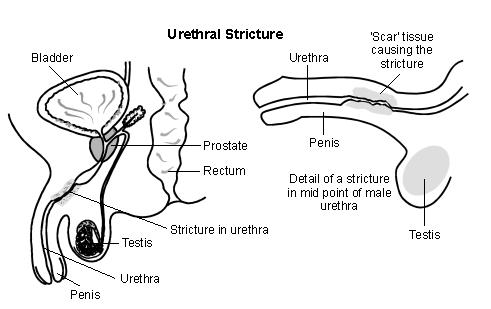
- Call : + 07523 300822
- Email : team@herefordshireurology.co.uk

Urethral problems
The urethra is the tube through which urine exits the bladder to the outside world when you pass urine. It passes through the penis in men. (In men semen is also ejaculated through the urethra).
In women the urethra is much shorter and ends just inside the anterior vagina.
What is a urethral stricture?
A stricture occurs when a part of the urethra becomes narrowed usually as a result of scarring. Any section of the urethra may be affected, the length of the stricture varies, it may be < 1cm or may involve the whole length of the urethra. The diagram below shows a fairly long and severe urethral stricture, many are shorter than this. Urethral stricture is uncommon in men and rare in women.

The rest of this information only deals with urethral strictures in men.
What causes a urethral stricture?
Injury or damage to the urethra can heal with scar tissue that may cause a stricture. There are various types of injury that can damage the urethra. For example: an injury may occur during medical procedures to look inside the bladder via the urethra: Radiotherapy treatment may damage the urethra; a fall on to the frame of a bike or a fall astride injury can cause damage.
Infection of your urethra is another cause- for example:
These infections usually clear with treatment but may leave some scar tissue at the site of the inflammation, which can cause stricture. Note that most urethral infections do not cause a stricture. A stricture is just one possible complication from a urethral infection.
What are the symptoms of a urethral stricture?
There may not be any symptoms initially. However, the following symptoms – which are likely to worsen with time –may occur:
What are the possible complications?
More pressure is needed from the bladder muscle to pass urine out through a stricture (it acts like a bottleneck). Not all urine in the bladder may be passed when you go to the toilet. Some urine may pool in the bladder. This residual pool of urine is more likely to become infected. This makes you more prone to bladder, prostate and kidney infections. A ball of infection (an abscess)) above the stricture may develop. This can cause further damage to the urethra and the tissues below the bladder. Cancer of the urethra is an extremely rare complication of a long standing stricture.
Are any tests needed?
However, like dilation, the stricture may re-form and the procedure may have to be repeated from time to time in some cases.
What is the treatment for a urethral stricture?
Treatment is usually advised to improve the flow rate of urine, to ease the symptoms and to prevent possible complications. Mr Christian Nayar will be able to advise on treatment, different options are available depending on the site and length of the stricture and also your age and general well-being.
Dilatation of the stricture
This is usually done by passing a thin plastic or metallic rod into the urethra. This procedure may be done either under a general or local anaesthetic. Rods of increasing thickness are gently inserted to gradually dilate the narrowed stricture. The aim is to stretch and widen the stricture without causing additional scarring. However, a stricture often tends gradually to narrow again after each dilation. Therefore, a repeat dilation is commonly needed every so often when symptoms recur. Some people are taught how to perform intermittent self-dilation (ISD) this means they insert a self-lubricating catheter into the urethra regularly to keep a stricture dilated.
As a rule, the shorter the stricture, the greater the chance of a cure with dilation. It is a relatively easy procedure to do and so may be tried first.
Urethrotomy
In this procedure, a thin telescope is passed into the urethra to see exactly where the stricture is. This is done under a general or spinal anaesthetic. A small telescopic knife is passed down the telescope to cut along the stricture. This widens the narrowed stricture. You will get relief of symptoms from this procedure. About half of people are cured for good by this procedure. About half of people are cured for good by this procedure.
Generally, the shorter the stricture, the greater the chance of a cure with this procedure.
If you are worried about a urethral stricture or a poor urinary flow make an appointment with Mr Christian Nayar to discuss this further.
Surgery
A corrective reconstructive operation called a urethroplasty can be performed if the above procedures do not work. Mr Christian Nayar can discuss these techniques with you and refer you to a regional expert. Various techniques can be employed; for a short stricture the narrowed tissue can be excised and the 2 healthy ends of the urethra are stitched together.
If the stricture is longer, then a graft may be taken from the inside of the cheek to form a new section of the urethra.